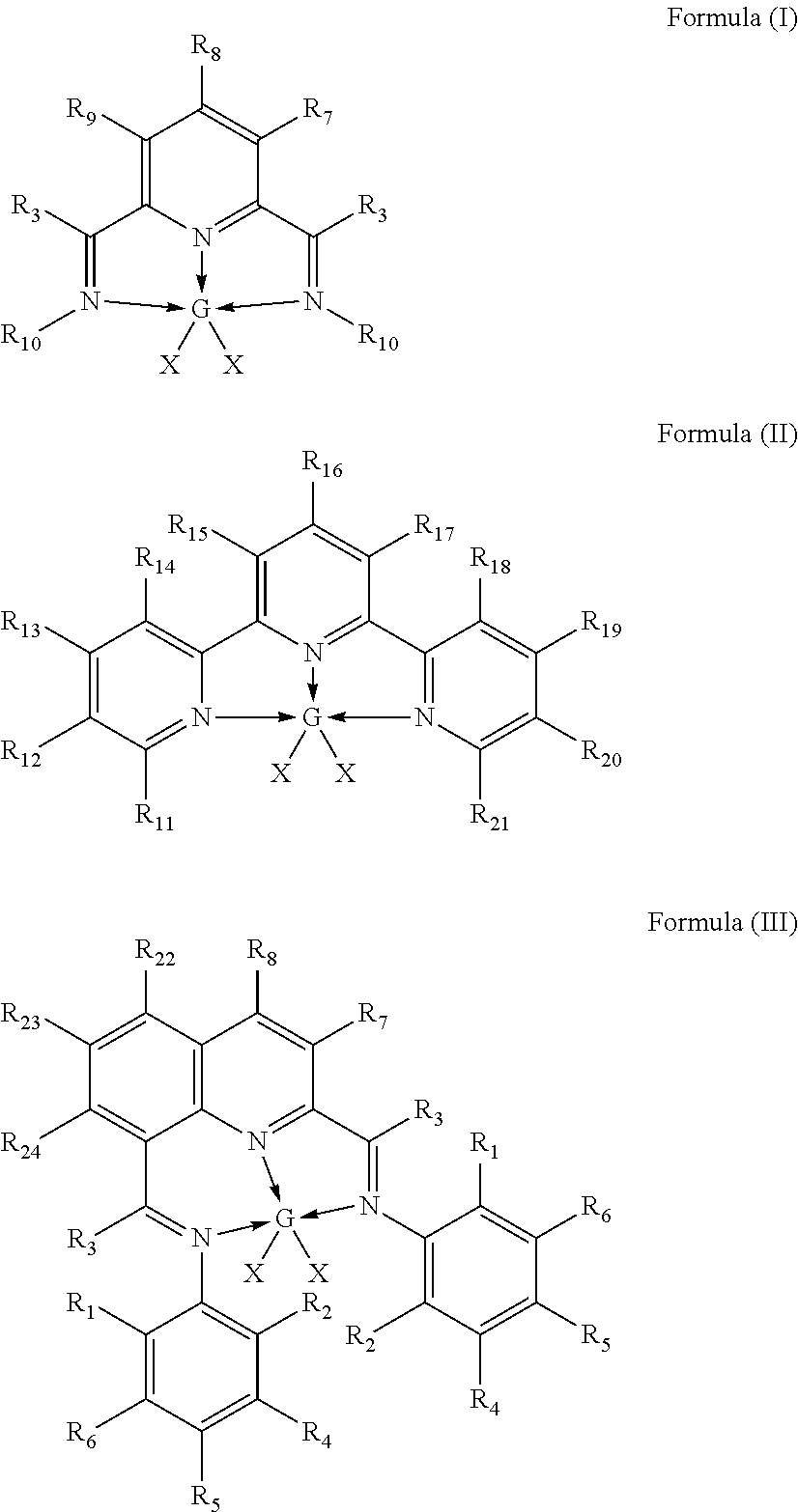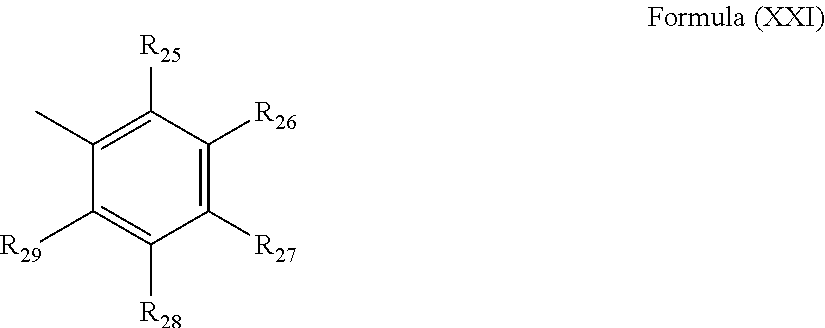In-situ activation of metal complexes containing terdentate nitrogen ligands used as hydrosilylation catalysts
a technology hydrosilylation catalysts, which is applied in the field of in-situ activation of tridentate metal complexes for use as hydrosilylation catalysts, can solve the problems of reducing the performance of precious metal complex catalysts in end-use applications, forming undesired odoriferous by-products, and inefficient catalytic performance of precious metal complex catalysts
- Summary
- Abstract
- Description
- Claims
- Application Information
AI Technical Summary
Benefits of technology
Problems solved by technology
Method used
Image
Examples
example 1
Hydrosilylation of 1-Octene with Methylbis(trimethylsilyloxy)silane (MDHM) with NaEt3BH as an activator and 2,6-Et2PDIFeBr2 as a catalyst precursor
[0123](2,6-Et2PDI)FeX2 (X—Cl, Br), which structure is shown below, was synthesized according to: Schmidt, R.; Welch, M. B.; Palackal, S. J.; Alt, H. G. Journal of Molecular Catalysis A: Chemical (2002), 179(1-2), 155-173.
[0124]
[0125]In an inert atmosphere, to a scintillation vial was added 0.150 g (1.33 mmol) of 1-octene and 0.229 g (1.03 mmol) of MDHM, followed by 0.006 g (0.01 mmol) of 2,6-Et2PDIFeBr2 (1 mol % to silane). A stir bar was added and a blue slurry was formed. With stirring, 0.020 mL (0.02 mmol) of a 1M NaEt3BH solution in toluene was added. The reaction was stirred at room temperature (23° C.) for one hour, then the reaction was quenched in air and analyzed by GC and NMR. The resonance associated with the Si—H in the 1H NMR was observed to completely disappear, and a new resonance upfield at 0.41 ppm assignable to methylene...
example 2
Hydrosilylation of allyl polyether having nominal structure H2C═CHCH2O(C2H4O)8.9CH3 with Methylbis(trimethylsilyloxy)silane (MDHM) with NaEt3BH as an activator and 2,6-Et2PDIFeBr2 as a catalyst precursor
[0126]In an inert atmosphere, to a scintillation vial was added 1.000 g (2.11 mmol) of allyl polyether having nominal structure H2C═CHCH2O(C2H4O)8.9CH3 and 0.470 g (2.11 mmol) of MDHM to form a substrate solution. To a separate vial, 0.013 g (0.02 mmol) of 2,6-Et2PDIFeBr2 (1 mol % to silane) was added to about 1.5 mL of THF to form a catalyst precursor solution. A stir bar was added to the catalyst precursor solution and a blue slurry was formed, and with stirring 0.040 mL (0.04 mmol) of a 1M NaEt3BH solution in toluene was added, immediately forming a red solution. The red iron solution was added to the stirring substrate solution, and the reaction was sealed and moved onto a 60° C. oil bath for 60 minutes. The product was analyzed by NMR-spectroscopy. The resonance associated with ...
example 3
Hydrosilylation of 1-Octene with Methylbis(trimethylsilyloxy)silane (MDHM) with NaEt3BH as an activator and [2,6-Diisopropyl-N-{(E)-1-[6-{[(1R)-1-1-tert-butyl ethyl]ethanimidoyl}-2-pyridinyl]ethylidene}aniline]iron dibromide as a catalyst precursor
A. Preparation of catalyst precursor [2,6-Diisopropyl-N-{(E)-1-[6-{[(1R)-1-1-tert-butyl ethyl]ethanimidoyl}-2-pyridinyl]ethylidene}aniline]iron dibromide
(A1) Preparation of 1-{6-[(2,6-Diisopropyl)ethanimidoyl]-2-pyridinyl}-1-ethanone
[0127]A 250 mL round bottom flask was charged with 5.00 g (30.64 mmol) of 2,6-diacetylpyridine, 6.00 g (33.84 mmol) of 2,6-diisopropylaniline, and 100 mL of methanol. A catalytic amount of p-toluenesulfonic acid was added and the reaction mixture was refluxed overnight. The reaction mixture was then cooled to approximately 35° C. to 40° C. and filtered to remove 2,6-bis[1-(2,6-diisopropylphenylimino)ethyl]pyridine. The reaction solution was then placed at 0° C. for 24 hours, and the solid was filtered, yielding...
PUM
| Property | Measurement | Unit |
|---|---|---|
| time | aaaaa | aaaaa |
| time | aaaaa | aaaaa |
| temperature | aaaaa | aaaaa |
Abstract
Description
Claims
Application Information
 Login to View More
Login to View More - R&D
- Intellectual Property
- Life Sciences
- Materials
- Tech Scout
- Unparalleled Data Quality
- Higher Quality Content
- 60% Fewer Hallucinations
Browse by: Latest US Patents, China's latest patents, Technical Efficacy Thesaurus, Application Domain, Technology Topic, Popular Technical Reports.
© 2025 PatSnap. All rights reserved.Legal|Privacy policy|Modern Slavery Act Transparency Statement|Sitemap|About US| Contact US: help@patsnap.com



